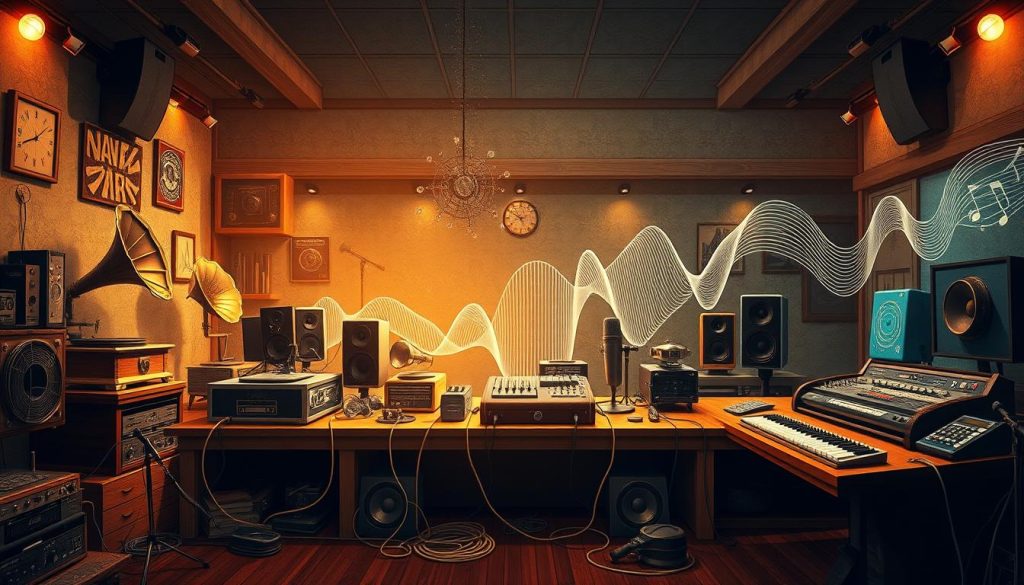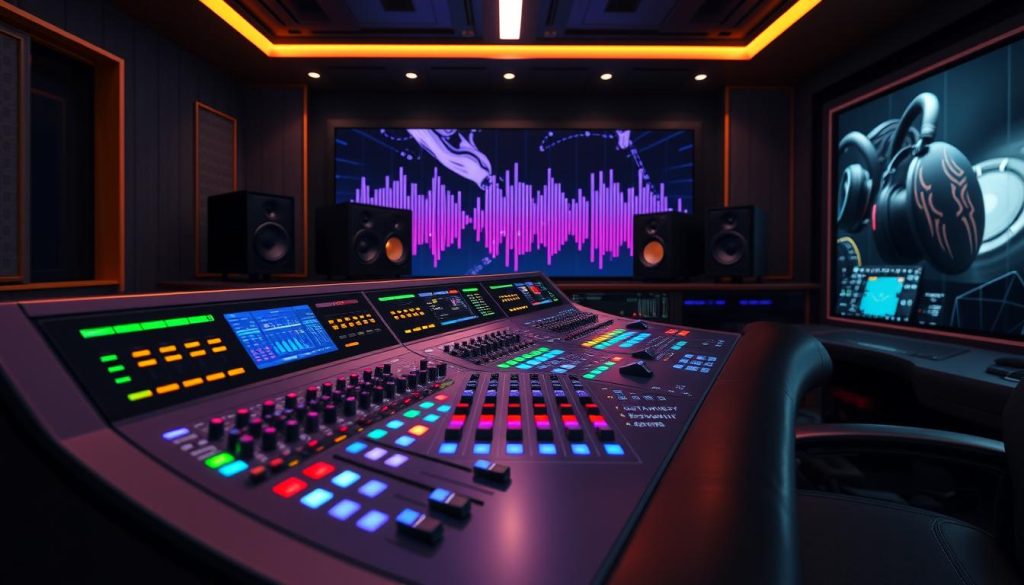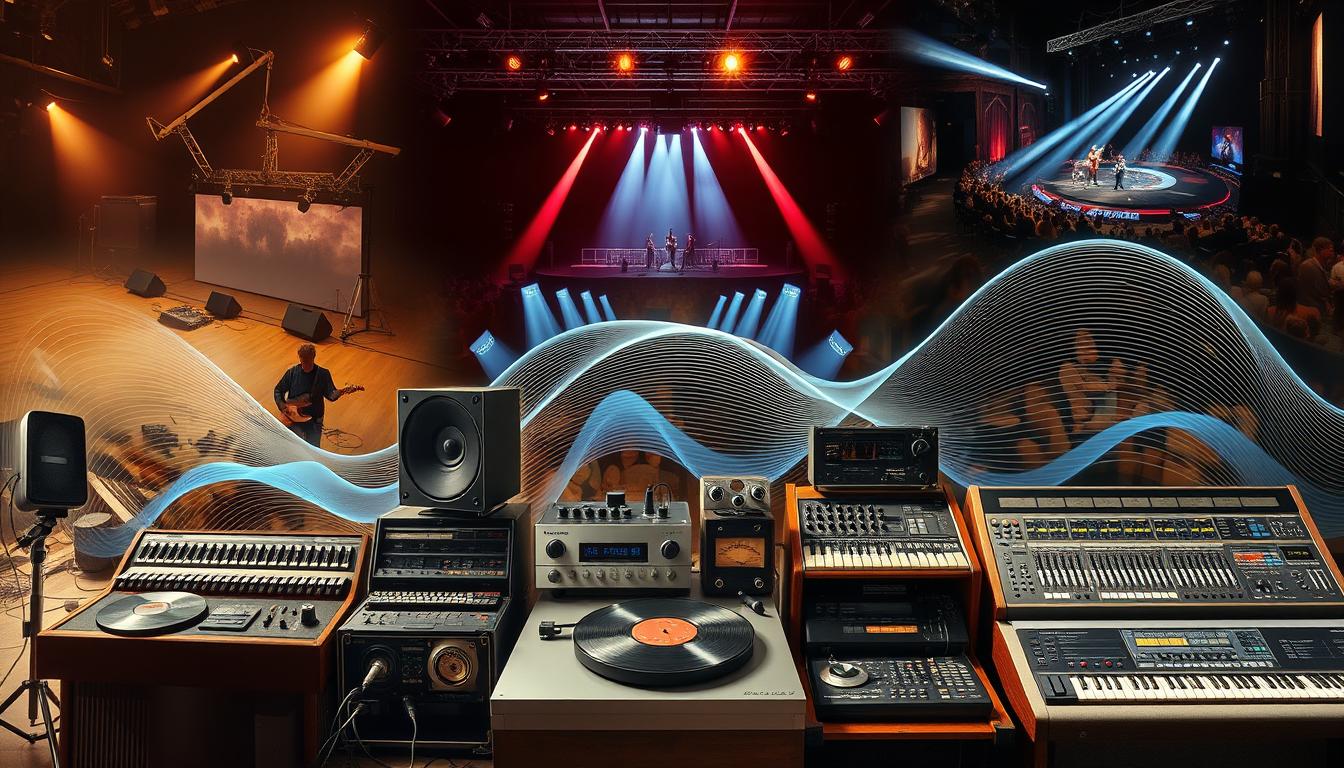I’ve always been drawn to the history of sound engineering. It’s amazing to see how far it has come. From the first analog recordings to today’s digital technology, it’s a story of constant progress.
This journey shows how the industry has changed over time. It’s all about making sound better and more complex. The history of sound engineering shows what humans can do with creativity and technology.
Let’s look at the key moments that changed sound engineering. We’ll talk about digital audio workstations and new microphone technology. This story is full of inspiration and excitement. Let’s dive into the history that brings us the amazing audio we love today.
From Analog to Digital: Embracing the Technological Shift
The world of sound engineering has changed a lot, moving from analog to digital. This change has been huge, bringing new ways to make and change audio.
The Birth of Digital Audio Workstations (DAWs)
DAWs have changed the game in the music world. They replaced old tape machines with something new and better. DAWs let sound engineers work more easily and flexibly.
They offer lots of tracks, precise editing, and many digital tools. This lets engineers shape sound with great precision.
Advancements in Signal Processing and Plugins
DAWs brought new plugins that have opened up more creative possibilities. These plugins add special effects to audio, like equalization and reverb. They let sound engineers be more creative and precise than before.
The move from analog to digital has changed sound engineering a lot. It has brought more creativity, flexibility, and precision. As technology keeps improving, the future of sound engineering looks bright for those who adapt.
Revolutionizing Recording Techniques
The world of sound engineering has changed a lot, especially with multitrack recording. This new tech from the 1950s lets sound engineers record each sound on its own track. This gives them a lot of control when mixing and editing.
This change has made sound engineering better. It lets engineers be super precise and creative in ways we couldn’t imagine before.
The Impact of Multitrack Recording
Multitrack recording changed everything in sound engineering. It lets engineers work on each sound separately. They can change the volume, where it sounds come from, and add effects to each track.
This has started a new chapter in making music. It lets for more complex and interesting songs.
Microphone Technology and Virtual Instruments
There have been big steps forward in microphone technology too. Engineers now have many types of microphones to choose from. This means they can record music in new ways, catching every detail.
Virtual instruments and sample libraries have also changed music making. Engineers can add sounds like orchestras and synthesizers without recording them live. This lets them try out new sounds and ideas easily.
| Technology | Impact on Sound Engineering |
|---|---|
| Multitrack Recording | Enhanced control and precision during mixing and editing |
| Microphone Technology | Expanded sonic possibilities and capture of musical nuances |
| Virtual Instruments | Facilitated creative experimentation and incorporation of diverse sounds |
history of sound engineering

The journey of audio engineering is amazing. It started in the late 19th century with Thomas Edison’s “phonograph”. This device changed how we hear sound.
Edison’s invention opened a new era. People could now listen to music and speeches outside of concert halls. This led to the creation of audio engineers. They work on making new audio technologies and understanding sound better.
Audio engineers have always been pushing the limits of sound. They introduced stereophonic sound in the 1950s. Then came portable technologies like 8-Track tapes and CDs. This shows how audio engineering and evolution of sound technology have grown.
Now, audio engineering keeps getting better. We have digital tools, signal processing, and virtual instruments. These have changed how music is made and shared around the world.
| Year | Milestone | Impact |
|---|---|---|
| 1877 | Thomas Edison invents the phonograph | Enabled mechanical recording and reproduction of sound, paving the way for the audio engineering profession |
| 1950s | Introduction of stereophonic sound | Revolutionized the listening experience by creating a more immersive and realistic soundscape |
| 1960s-1970s | Development of portable listening technologies (8-Track, compact cassette, compact disc) | Democratized access to recorded music and transformed the way people consumed audio content |
The story of sound engineering is full of innovation and progress. It goes from Edison’s phonograph to today’s digital music production. This history has led to many new technologies that change how we hear and interact with sound.
Transforming Mixing and Mastering Processes

The world of audio engineering has changed a lot in recent years. This change is especially true for mixing and mastering. We no longer use just big, old equipment. Now, digital mixing consoles and mastering software have changed how we work with audio.
The Rise of Digital Mixing Consoles
Digital mixing consoles have brought new precision and control to mixing. Engineers can now work on each track, add digital effects, and adjust sound with great precision. This is all done on a computer with a digital audio workstation (DAW). This change has made mixing easier and allowed for clearer and more balanced sound.
Mastering for Streaming Platforms
Streaming has changed mastering too. More people listen to music on phones and speakers, not just stereos. So, mastering engineers now make sure the music sounds good on all devices. They make sure the music is perfect for streaming platforms.
Digital technology has changed audio mixing and mastering a lot. It lets engineers do amazing things with sound. From precise digital consoles to making music for streaming, the future of audio engineering looks bright.
| Feature | Analog Mixing | Digital Mixing |
|---|---|---|
| Precision | Limited | Unparalleled |
| Workflow | Cumbersome | Streamlined |
| Effects Processing | Hardware-based | Software-based |
| Mastering for Streaming | Challenging | Optimized |
Live Sound Reinforcement: Elevating the Performance Experience
Technology has changed how we enjoy live sound. Digital mixing consoles have made setting up easier and cut down on big equipment. Now, sound engineers have more control over the sound.
They can use many tools like dynamic processors, equalizers, and reverbs easily. This has made live shows better.
Wireless tech has also changed live sound. Engineers can manage many mics and systems without long cables. This lets artists move freely and connect with the audience better.
This tech has made the job easier for sound engineers. It also makes the show better for everyone. Fans get to hear music that matches the energy of the show, making it unforgettable.
Embracing the Digital Revolution
Switching to digital mixing consoles has changed live sound a lot. These consoles are smaller and easier to use. They let engineers change the sound easily and apply new effects.
This has changed how live shows sound. The sound is always good and draws the audience in.
Wireless Connectivity: Enhancing Mobility
Wireless tech has given sound engineers more freedom. They can move around the stage easily. This helps them set up the sound better and respond to the show.
Artists can also move more and connect with the crowd. This makes the show better for everyone.
| Technology | Impact on Live Sound Engineering |
|---|---|
| Digital Mixing Consoles | Simplified setup, advanced signal processing capabilities, and improved audio quality |
| Wireless Technology | Enhanced mobility for sound engineers, reduced cable clutter, and greater flexibility for artists |
Live sound engineering is always changing. These new technologies have made shows better for everyone. They help artists and make the music more immersive.
Integration of Sound Engineering and Virtual Reality
Technology is always changing, and sound engineering is now in a new area with virtual reality (VR) and augmented reality (AR). Sound is key to making experiences feel real. New tech lets sound engineers place sounds around you in a 360-degree circle.
VR and AR have changed the game for sound engineers. They can now make sounds that match what you see, making everything feel more real. This mix of sound engineering and new tech is changing entertainment, games, and learning. It’s making new kinds of creative and sound experiences possible.
Sound engineering is making VR and AR better in many ways. It makes games and educational VR more real with amazing sounds. By using special audio tricks, sound engineers can make you feel like you’re in a new world.

